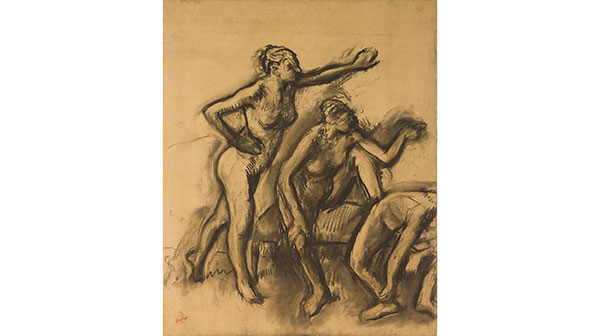This esay analyzes two artworks from the exhibition “Degas at the Opéra” posted in the National Gallery of Art. Edgar Degas was considered an admirer of ballet dance art, a topic that was predominantly painted by him (Feldman n.d.). Although there are many drawings on the topic of ballet, this is the first exhibition that focuses on opera. The first artwork is “The ballet from “Robert le Diable,” and the second artwork is “Three Nude Dancers.” The analysis was made based on art’s form and function and its language.
The artwork “The ballet from Robert le Diable“

- Title: The Ballet from Robert le Diable.”
- Artist: Edgar Dega
- Media: oil
- approximate size: 26 x 21 in.
I chose this art piece because I find the scene from the ballet theatrical and romantic in its way. Dega portrays the nuns rising from their graves swirling around the stage. The dancers can feel the music when they are performing, so did the nuns on the canvas. They responded to the orchestra with graceful moves full of emotions. “The ballet from Robert le Diable” is a fine art drawing in impressionism style. Dega was inspired by the scene of nuns from the “Robert le Diable” orchestra led by Laure Fonta. Dega’s friend Désiré Dihau, a bassoonist, played in the orchestra (“The ballet from Robert le Diable”). It might be another reason why Dega came to see the performance and decided to draw this painting. “The ballet from Robert le Diable” artwork’s esthetic is in contrast between black and white colors that Dega used. The ballerinas in white clothes stand out from the dark background, dancing in front of the people sitting in the dark hall, indifferently watching the performance.
The painting is dominated by vertical lines in the form of scenery. Vertical lines are parallel to the earth; that is why they suggest a sense of height, something that is difficult to reach. Indeed, the ballerinas in the painting are immersed in their world, overlooking the spectators. Curves were also used to convey a softening effect, as they resemble the human body. The curves of the human silhouette soften the sharp edges of the scenery. The effect of three-dimensional space can be seen in the painting, as well. Dega achieved this effect through shading and perspective drawing. The artist chose dull and dark colors to impart a sense of mystery and a serious mood that comes from the performance. He could also portray a material of the scenery, which is probably made of wood, as well as the costumes of the ballerinas that look like they were made of silk. The painting has a horizontal line of symmetry that creates visual equilibrium and makes the work balanced.
The artwork “Three nude dancers”

- Title: Three Nude Dancers
- Artist: Edgar Dega
- Media: charcoal on paper
- approximate size: 30 x 25 in.
The purpose of choosing the “Three nude dancers” is that it depicts ballet dancers with no context, which allows for thinking and observation. According to the narrator of the exhibition, Dega considered himself similar to ballet dancers, as he always sought excellence in his work as ballet dancers do (Feldman). Dega observed movements and traced them on the transparent paper. The traces of the original drawing can be seen, which means that Dega tried to correctly depict the position of the dancers erasing the imperfections. These alterations and residues of original lines allowed people to observe his working process. The dancers are depicted nude, probably, because Dega wanted to concentrate purely on the movements without any unnecessary things. The aesthetics of this work is in its minimalism, lack of context, and Dega’s obsession with perfection. By carefully observing, he could accurately transform movements from life to paper.
The dancers occupy positive space, and the white space behind them is negative. The amount of positive space is higher, meaning that the accent is made on dancers and their body motions. Dega used charcoal and transparent paper for drawing that allowed him to change the lines and chase movements. The painting has the illusion of three-dimensional space as if the dancers were alive, and this was achieved by using shading and leaving the original lines not erased. The painting seems to be balanced, and it has a bilateral symmetry as there are human bodies depicted in the picture.
Analysis of the tour
The type of tour that I had was an audio tour organized by the National Gallery of Art. This tour was narrated by the director Kaywin Feldman. It was possible to move through different locations by switching the audio files. I found the interface of the page convenient as each artwork was denoted as a “stop.” So, I could easily switch from one artwork to another by clicking on the audio. I liked that it was not only the narrator speaking but also the exhibition curator, artistic director, and even ballet dancers. In my opinion, art exhibitions can develop one’s critical thinking and imagination. For example, while I was going through each “stop,” I exercised my critical thinking to see what the artist meant by drawing each part of the work. I tried to see the painting through his eyes, so I had to get imaginative. It was also an exciting experience because I rarely visit virtual art exhibitions. I discovered that there is not much difference between live and virtual exhibitions, and later is even more convenient. It is exciting that new technologies allow cultural enrichment without leaving home.
References
- Feldman, K. (n. d. a). (Executive Producer). (No. 2). The ballet from Robert le Diable [Audio podcast episode]. Degas at the opéra. Web.
- Feldman, K. (n. d. b). (Executive Producer). (No. 15). Three nude dancers [Audio podcast episode]. Degas at the opéra. Web.
- The Ballet from Robert le Diable. (n.d.). The Metropolitan museum of art. Web.